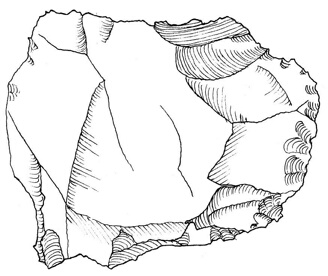|
Mesolithic
(10000
- 5000 B.C.)
The
Mesolithic landscape around Elgsnes was quite different from
today’s. Remnants of the continental glacier lay in the valleys
and interior districts. The continuing melting of the glaciers
opened up new tracts of land. The birch spread along the coast,
and the pine followed later. As the ice melted, its pressure
on the land diminished, and, as a consequence, the land slowly
rose from the sea.
 |
Flake
axe from the early Mesolithic.
Found at Overlandet.
Ill.: M. Skandfer
|
People
have lived at Elgsnes ever since the beginning of the Mesolithic,
at least ten thousand years ago. Evidence of this has been found
under the ground. The oldest find is a flake axe made of fine-grained
quartzite. This was a multi-purpose tool for scraping and cutting.
Other finds from the Mesolithic are cutting tools called blades,
made of flint or the hard and fine-grained stone called chert.
But who was it that made and used these tools? Where did they
come from and what did they live off?
Immigration
One
used to believe that the first humans that came to northern
Norway were reindeer hunters, moving up from the south. But
presently geologists maintain that the coasts of Finnmark and
the Kola peninsula were freed from the ice earlier than previously
believed. Therefore the immigration may have emanated from either
of the proposed directions. Recent archaeological research has
shown that the whole coast was populated virtually simultaneously,
perhaps after a couple of generations. South Scandinavian flint
found at Elgsnes shows that the people here were not isolated,
but that there was contact over vast distances already in the
Mesolithic.
Settlement
The
rich fishing to be found in the adjacent Andfjorden and Toppsundet
must have been the primary reason for settling at Elgsnes. But
possibilities for dietary variation were also present: Walrus,
seal, shells, birds and eggs, in addition to various flora and
fauna, would have made the site attractive in the Mesolithic.
Those who lived here must have had boats for transport, hunting
and fishing.
No
traces of early Mesolithic houses have been found in northern
Norway, but remains of hearths have been uncovered at several
archaeological sites. We therefore presume that these people
lived in tents. Towards the end of the Mesolithic they have
also built permanent habitations. The archaeologists are of
the opinion that these people moved between two or more sites
during the year, for which tents would have been practical for
transport and easy to erect.
A
fixed yearly itinerary probably existed for these movements.
We presume that Elgsnes was such a seasonal site in the Mesolithic,
where the same community stayed a specific season every year.
If they were here for the winter fishing, they probably dried
the fish and brought it with them as provisions when they moved
on to their next quarters.
Even
if the groups made use of a large territory, they probably did
not consist of more than 25 to 100 members. Some months they
may have lived dispersed, while they congregated at a large
common site for other parts of the year. Differences of status
would have been based upon age and gender, and not upon one’s
ancestors or family. Every group had a leader, who was always
dependant upon the support and trust of the others.
|
|
Blade
from the Mesolithic.
Ill.: L. B. Myklevoll
|
|